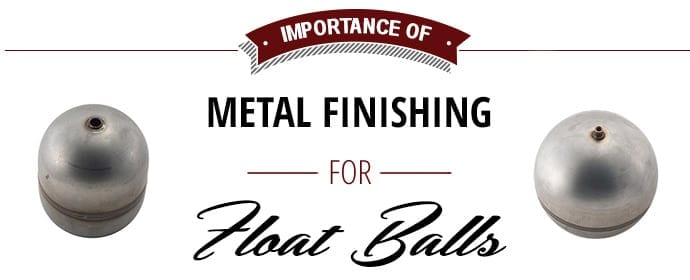
Metal finishing for float balls is a special process used in float and tank applications. Finishing may require treating the exterior or interior of the float ball for a variety of purposes. A particular surface finish is necessary for a food environment. Weighted float balls may be necessary for specific gravity requirements when tanks have heavier liquids or more than one liquid in them. Magnets may be located within float balls to actuate float switches. There are numerous types of processes that require metal finishing for float balls. Here are several metal finishing methods offered by Arthur Harris and their intended applications.
Chemical Cleaning
Float balls used in many tank applications are necessary for maintaining liquid level control to ensure the safety of the facility. Liquid chemical properties can be altered frequently via heating, cooling or being mixed together. Chemical cleaning is a finish designed to withstand the fluctuating properties in harsh chemical environments. Used on stainless steel float balls and other metal parts, cleaning service includes alkaline, solvent, vapor degreasing, ultra-sonic, acid pickling, and supercritical CO2 types.
Anodizing
An anodized metal surface undergoes an electrochemical process that integrates and converts its surface with a decorative, corrosion-resistant, durable, anodic oxide finish for use in float balls and tank applications. The process provides a highly durable and attractive finish to the exterior of the metal, requiring minimum-maintenance. Anodizing can be accomplished in a number color finishes as well as hard-coating the surface and ideal for harsh environmental conditions.
Heat Treating
A heat treating finish is a series of techniques that include carburizing, carbonitriding, annealing, cleaning, case hardening, water quenching, and more. Heat treating is often used to improve the mechanical properties of a particular metallic alloy. Where necessary, the properties can be manipulated to improve hardness, strength, toughness, ductility, and elasticity of the metal.
Passivation
A passivation finish improves the corrosion resistance of stainless steel. The process is a method that removes ferrous contaminants, especially free iron particles that could oxidize the metal surface, restoring them to their original corrosion specifications. Passivation is used in float ball and tank applications for its corrosion resistance, and for cleaning surfaces.
Polishing & Buffing
Buff polishing provides a smooth, non-textured finish to float balls that results in a high, glossy sheen. The process is often used for decorative products but is also used in food environments where a sanitary finish is required. Without treatment, submerged stainless steel is subjected to discoloration and bacteria growth. Sanitary finish to float ball metals is vital to prevent bacteria growth with food-grade products. A fine finish to the metal surface removes fine particulates or scratches that could otherwise trap bacteria and aids in proper washing and cleaning.
Weighted & Magnetized Finishes
Finished weight requirements for floats are often necessary when heavier liquids are used in tank applications, or when multiple liquids of varying weights are used in tanks, e.g., oil and water. Floats can be loaded with a variety of materials such as sand, shot, or even water. A fixed load can be attached to the interior of the float if needed. Magnetic floats are necessary to trigger magnetic reed switches in liquid level controls.
For more information on the metal finishing process, please contact the experts at Arthur Harris today.




